
|
SMART Ideas!
Healthy & Natural Floor Cleaning
by Alice Osborne
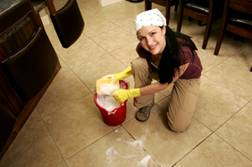 At our house we've been cleaning the floors lately, and would we love a little miracle-type help with this challenging chore! Sadly, most conventional cleaning products that promise an easy clean and sparkling floor, are terrible for our health and the environment. The EPA says using conventional cleaning products on your floor is like spreading potentially toxic chemicals across the largest surface area of your home. Their study shows indoor levels of pollutants (formaldehyde, chloroform, and styrene) range from 2 to 50 times higher than outdoor levels—much of it from conventional cleaning supplies.
Floor cleaners that shine also give off-gassing of petroleum-based polymers. In addition, most of the fragrance that accompanies conventional floor cleaners are either indoor air pollutants on their own, or mix with ozone to create formaldehyde and other toxic air contaminates.
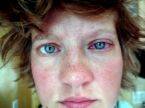 People exposed to floor cleaners can experience eye irritation, dizziness, loss of concentration, fatigue, wheezing, coughing, asthma attacks, respiratory infections, and hypersensitivity pneumonitis.
While we can’t provide a miracle per se, we can show you how to clean your floors without compromising your health. The key to minimizing the need for cleaning formulas is good regular maintenance. Dirt on the floor can abrade the surface making it even harder to clean. Here are some “smart” techniques that reduce the need for cleaning:
Place doormats at entrances (called walk-off mats, they reduce dirt, lead and pesticides).
Ask that shoes be removed at the entrance.
Plan regular sweeping, vacuuming or dust-mopping.
Different flooring surfaces require a specific type of cleaning process. Using the wrong method and formula for your specific flooring material can eventually (or quickly) ruin the floor. For all of the following tips, please test first on an inconspicuous area to determine compatibility with your floor.
We’ll start with wood. Floor care for wood floors isn’t the same. Determine if your wood has a surface or penetrating finish.
WOOD FLOORS: SURFACE FINISH
This floor is very shiny and glossy, and is protected by a coating that sits on top of the surface. Such coatings are varnish, polyurethane (urethane), acrylic and epoxy.
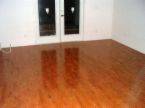 Damp mopping wood floors with a surface finish: Damp mopping wood floors with a surface finish:
Wet the mop and wring as much water out as possible. Go over the floor twice, first to dissolve the dirt and then again, after rinsing the mop and ringing it thoroughly, again to rinse. Buff dry with a towel—easily done by attaching a towel to a clamp-mop handle.
Don’ts:
Don’t use oil soaps, wax cleaners, or products that promise “shine.” They leave build up and create problems when it’s time to put a new surface coat on the floor.
Don’t use vinyl or tile floor care products on wood floors. Acrylic waxes create a slippery and cloudy finish—which can only be fixed by sanding and refinishing.
Don’t use ammonia cleaners they will dull the finish and performance of your floor.
Don’t use vinegar. Low pH cleaners (acidic, like vinegar) can dissolve hard water and mineral deposits, but can’t tackle dirt and grime. Since it is an acid, it eventually dulls the finish.
Don’t use high pH cleaners (more alkaline, like harsher soaps). They’re good at dissolving dirt and grime, but also eventually dull the finish.
Dos:
The best non-toxic floor cleaning solution is ¼ of a cup of mild liquid dishwashing detergent added to a bucket of warm water (for damp mopping).
For scuff marks use a sprinkle of baking soda on a damp sponge and rub.
WOOD FLOORS: PENETRATING FINISH
This floor has more of a matte finish; you may be able to feel the grain of the wood—these floors are protected by the oil or wax that has sunk into the wood. Penetrating finishes include resins or sealers such as Danish oil, linseed and tung oil.
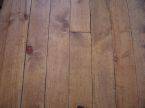 Don’ts: Don’ts:
Don’t (ever) use a water based cleaner on a penetrating finish floor.
Don’t use cleaners specified for a surface finish, they can turn a penetrating finish cloudy.
Dos:
Use solvent-based cleaners (natural citrus solvents rather than a mineral spirit or turpentine based). Spray a light film on the floor and dry mop with a microfiber or regular dust mop.
Wipe spills up immediately with a lightly water dampened cloth and then hand-buffed dry.
To remove white spots caused by water spills, use the finest steel wool and a small amount of natural citrus solvent; rub gently in a circular motion until spot is gone. Then apply a bit of jojoba oil to the area and buff.
LAMINATE FLOORS
The top layer is hard melamine over a layer of printed paper—very durable and very easy to clean. Just follow manufacturer’s directions, but avoid their cleaning products—you don’t need them.
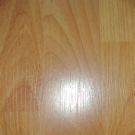 Don’ts: Don’ts:
Don’t use soap-based cleaners or “mop and shine” products—they will make the floor cloudy.
Don’t use abrasive cleaners, steel wool, or scouring powder—they’ll scratch the floor.
Don’t wax or polish your floor.
Dos:
Vacuum, use a dust mop or wipe with a damp cloth.
For spills, wipe with a cloth or sponge.
RESILIENT FLOORS
They’re softer and include vinyl, linoleum, and cork. Don’t confuse linoleum with vinyl. Vinyl is synthetic, while real linoleum is made from natural ingredients (wood flour, rosins, ground limestone, powdered cork, pigments, jute, and linseed oil).
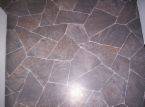 Don’ts: Don’ts:
Don’t use solvent-base products, they soften and damage resilient flooring.
Don’t scour. For tough stains, make a paste of baking soda and gently wipe with a wet rag.
Dos:
Sweep, dust mop or vacuum frequently.
Damp mop with a mild all natural liquid dish detergent and warm water.
Damp mop with a 1/2 cup of vinegar added to the water to rinse and increase shine.
Remove scuffs by dipping a sponge in jojoba oil and rubbing lightly—then wipe.
CERAMIC TILE FLOORS
Smart advice from The Old House Web: pre-wet ceramic tile floors before using any cleaners. Water saturates the porous tile and prevents cleaning agents from penetrating into the tile body. Floor tiles should be always rinsed thoroughly after cleaning.
 Don’ts: Don’ts:
Don’t use harsh abrasive cleaners that might scratch the glaze.
Don’t use acid-based cleaning solutions—they damage complex silicates in the glaze.
Dos:
Regularly maintain by sweeping, or preferably dry or damp mopping or vacuuming to reduce grit.
Always start with the gentlest method possible, which may be as simple as warm water.
Damp-mop with a low pH mild detergent. Dry the floor with a soft cloth to avoid streaks.
Information courtesy, Melissa Breyer of Care2.
(If YOU have a smart idea, won't you share it? Life is so much easier and we accomplish so much more when we pool our resources. And after all, we're all in this together. So email patty@dvo.com or alice@dvo.com with YOUR Smart Ideas!)
Contribute to the Cook'n Club!
DVO would love to publish your article, prose, photography and art as well as your cooking, kitchen and nutrition tips, tricks and secrets. Visit the Newsletter Submission / Win Win for All section in our Forum for more information and details.
|
|



